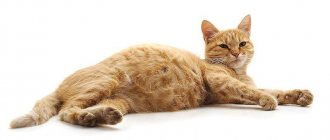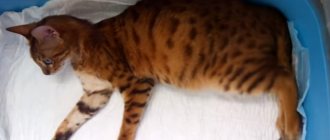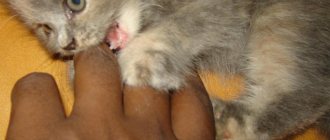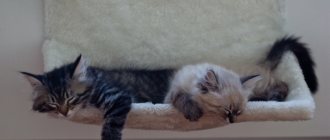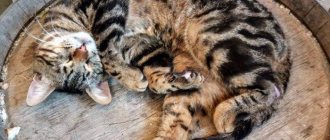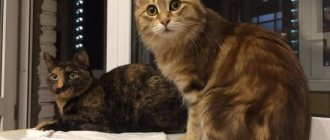When a person gets a pet, namely a cat, he must understand that after some time it will grow up and begin to produce offspring. It is worth emphasizing that these animals are especially prolific and can give birth up to several times a year. Many readers are interested in this question: how many kittens does a cat give birth to for the first time? After all, if the offspring turns out to be large, this will be a problem for both the cat and the owner. The first one should feed all the children, and the second one should be sure to place them in good and caring hands.
Duration of pregnancy
A cat's pregnancy lasts on average about 9 weeks. A more accurate period depends on many factors such as age, weight and breed characteristics. For example, owners have found that the process of bearing offspring in short-haired females lasts 58-68 days, in cats with long and medium-length hair it lasts 63-72 days.
How many kittens can a cat give birth to?
The length of pregnancy is also affected by the number of babies inside the womb. The more there are, the earlier the due date will come. Females bearing one to two kittens are able to walk for as long as possible before giving birth. In addition, their health depends on the number of cubs. Statistics show that babies from multiple litters are weaker and sicker.
For your information! In one litter, a female can bring from 2 to 8 kittens, the exact number of which depends on many factors.
Induction of labor
If the due date has come, the cat’s body temperature has dropped to 37°C, more than two days have passed, then you need to know how to induce labor in a cat. First, they try simple remedies: massage the tummy and nipples: this will cause the production of oxytocin, and it will start the process of contractions. It is dangerous to administer oxytocin on your own - physiological unpreparedness for lambing can lead to cervical rupture.
If two days have already passed, signs of labor are evident, but the process has not started, then contact a veterinarian.
What determines the number of kittens a cat has?
Can a cat give birth to one kitten or not all at once?
The number of future offspring is influenced by a number of conditions.
One of the factors influencing the number of kittens in a litter is the breed of the mother
Maternity age and number of births
A young cat who becomes pregnant for the first time carries fewer babies compared to a mature female. Usually in her first birth she brings 2-3 kittens. But there may be exceptions, for example, if a cat is pregnant at 5-6 months, she may give birth to 1-2 kittens, which most likely will not be viable.
Each subsequent pregnancy increases the number of fetuses. Once a cat reaches 8 years of age, the number of fetuses gestated decreases, since the elderly body is no longer able to cope with such a load. Veterinarians do not recommend giving birth to cats that have reached this age.
Genetic predisposition
The fertility of the pet is passed on from mother to kitten. Therefore, if a mother cat brought 4-5 kittens at a time in a litter, then her daughter cat will most likely give birth to the same number of babies. Conditions of detention and state of health, of course, should be the same for the mother and her offspring.
Living conditions and food
Animals that have not received a sufficient amount of essential microelements and vitamins during the period of active growth and development are able to bear no more than 3 kittens. The same applies to adults with little or unbalanced nutrition.
Important! Weakened and exhausted females are not able to bear and give birth to viable babies.
How many kittens a cat gives birth to on average also depends on the cat, more precisely on its age and state of health. The presence of cryptorchidism, immune diseases and other problems reduces the number of offspring. The quality of nutrition, quantity and frequency of mating are also important, since frequent mating affects the quality of the seminal fluid.
Physiological characteristics of a cat
An important role in how many kittens a cat will have is played by the physiological characteristics of the partner.:
- Age. Excessively young or, conversely, old cats have less “productivity”.
- Number and frequency of matings. With increased sexual activity of a cat, the quality of its sperm deteriorates.
- Health. It is important that the future dad does not have diseases of the genitourinary system, as well as infectious diseases.
- Sexuality. In cats, ovulation occurs during mating and the number of eggs produced is influenced by the intensity of the partner’s “courtship.” Interestingly, felines are characterized by superfecundation, i.e. fertilization of eggs with sperm from different individuals. Thus, one litter may contain kittens from different fathers.
How many kittens can a cat give birth to at one time, depending on the breed?
How long after giving birth can a cat become pregnant?
Most breeds are not particularly fertile; their representatives, on average, produce 2-3 kittens, less often 4.
Pedigree cats usually have only a few kittens.
Yard cats without a breed can bear up to 8 babies at a time. There are exceptions, for example, there have been cases when a Persian cat gave birth to 15 cubs in one litter. But such a multiple litter is characterized by low weight and poor health, which sharply reduces the possibility of full growth and development. In addition, the female is simply not able to feed such a number of kittens.
For your information! Often, when more than 6 babies are born, 2-4 of the weakest ones die in the first week.
The Scottish Fold on average bears 2-3 kittens, but if mating occurs with a yard male, the number of offspring can increase to a maximum of 6-8 cubs.
The British breed and Maine Coons are classified as multiple breeds. A well-fed, healthy female can give birth to 4-6 kittens at a time.
How to determine the number of cubs
How long does a cat bear kittens: examples by time and for the first time
Today, there are three methods by which you can determine how many kittens a pregnant cat gives birth to:
- The genetic method is based on the fertility of the pregnant female's mother. If a mother cat on average gave birth to 5-6 kittens per litter, then her female cubs will also bear 5-6 babies. If a female gave birth to 2-3 kittens, then the future offspring are unlikely to have a larger litter.
- The folk method is based on many years of observation of owners of cats of various breeds. The number of cubs is equal to the difference between the swollen mammary glands of the female during pregnancy minus two. The result is not 100% guaranteed, but in most cases it turns out to be correct
- The scientific method is considered the most accurate of all existing ones and is carried out a week or two before the upcoming birth using ultrasound equipment.
The most accurate method for determining the number of kittens is ultrasound
Important! It is strongly not recommended to palpate the belly of a future mother, as such actions can damage the soft bones of unborn kittens and put the cat in a stressful state.
Postpartum period
The absence of contractions for 2 hours and the prolapse of the abdomen indicates the completion of the birth process. The behavior of the female also changes: she calms down, her breathing evens out, she lies down more comfortably in the box, and continues to lick and feed the babies. You should not give food to a woman in labor immediately after birth, but you can offer water or milk. She usually drinks only when the process is over.
You need to carefully replace the diapers with clean ones and place a tray nearby so that the mother does not move away from the kittens for a long time. But it is not recommended to pick them up; the cat may lose interest in them or react aggressively to this. It's better to leave her alone for a while.
Is there any way to increase the number of kittens in a litter?
Owners of purebred cats who bear 1-3 kittens at a time may face a similar question. The number of kittens can be influenced with the help of medications.
For example, in advance of the planned mating and pregnancy, special preparations of a hormonal or homeopathic nature are added to the pet’s diet. Hormonal medications are prescribed only by a veterinarian after a thorough examination of the cat’s health.
It is important to follow the regimen and dosage of taking hormones, otherwise you can provoke a hormonal imbalance in the female’s body. Homeopathic medicines such as “Gamavit” and “Ovariovit” allow the ovaries to recover and produce healthy, high-quality eggs in greater quantities than before starting the course of taking the drug.
Vitamin E and selenium in small doses have a positive effect on the reproduction of the cat's body.
Important to consider! Only a veterinarian can calculate the correct dosage, taking into account the physical characteristics of the cat, so it is not recommended to do this yourself, so as not to harm the health of the pet.
How does the number of babies affect the health of the mother?
Stimulation of multiple pregnancy can lead to the development of unfavorable processes in the body of the cat and its offspring:
- The birth of weak, non-viable offspring. During pregnancy, a large number of embryos cannot always receive a sufficient amount of nutrition, and with it a minimum of useful microelements. The anatomical features of the female may be unsuitable for bearing such an offspring; accordingly, the cubs will not have enough space in the womb, which affects their size.
- Increased risk of complications during childbirth and the postpartum period, which can lead to forced surgery to remove the uterus and ovaries.
- There is a likelihood of a shortage of mother's milk in sufficient quantities for each baby, which will require owners to purchase artificial nutrition. You will also have to take the time to syringe feed the kittens.
A small pregnancy is no less fraught with consequences. For example, one kitten in the womb will receive everything it needs from its mother for several, eventually growing to a large size and getting stuck in the birth canal. And the production of a large amount of milk, which 1-2 cubs simply cannot eat on time, can lead to the development of mastitis.
Main stages
The process of forming kittens from conception to birth is quite complex.
The following important stages of their development during pregnancy are distinguished:
- The first stage covers a month after mating the animal. Hormonal changes occur in the body. This affects character and behavior. The cat becomes affectionate and calm. Her nipples swell and their color changes. The process of embryo formation begins in utero.
- The second stage includes 5-6 weeks of pregnancy. The pet is sleeping at this time and needs a sufficient supply of food. The future offspring develops intensively inside the mother. This can be seen as the cat's belly size and weight increase.
- At the next stage, the future kittens are formed. They gain weight and become active, which causes the abdomen to sag. The cat changes dramatically: the maternal instinct awakens. She prefers to be with small children if there are any in the house.
- The time of formation of fur in cubs is difficult. During this period, all internal systems of the body are launched. Due to the increased intensity of metabolic processes, the excretory function increases. This affects the condition of the expectant mother. Her appetite decreases, which can lead to a complete refusal of food.
- The last stage begins at 8 weeks. Future kittens are quite large. The mother cat may have urinary incontinence. 1-2 days before lambing, she becomes restless and begins to look for a place where she can give birth to kittens.
How many kittens can a cat have in her lifetime?
Cats are characterized by high fertility; on average, from 3 to 8 kittens can be born in one litter.
How many babies can a cat have in her lifetime?
Over the course of her entire life, one female can give birth to up to 200 cubs. The record holder for the number of offspring was the outbred tortoiseshell cat Dusty from America, who gave birth to 420 kittens.
Modern medical technologies allow the owner to control the number and frequency of cat pregnancies, as well as facilitate the birth process. The main thing to remember is that the health of the pet and future offspring depends entirely on a balanced diet, conditions of detention and care.
Tool for combing the hair of cats and dogs My Rules (deshedder, comb, slicker) size M
711 ₽ More details
History of Russia for children. Book Butromeev V.P. | Butromeev Vladimir Petrovich
888 ₽ More details
Drinkers for rabbits
